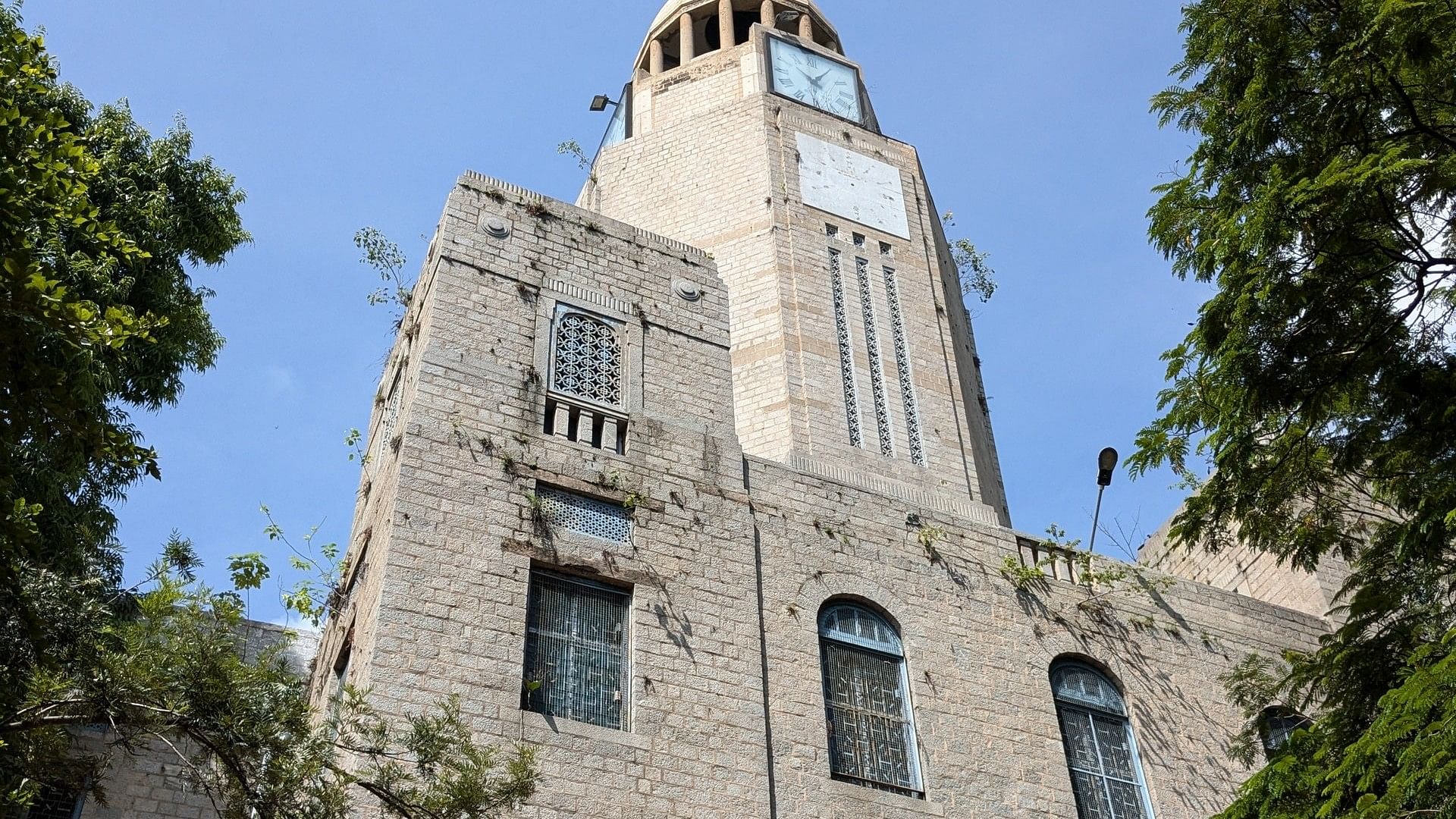
The rear facade of the Silver Jubilee Technological Institute.
Photo: Darshana Dave
The clock strikes 10 at the Government Sri Krishnarajendra Silver Jubilee Technological Institute. On the road in front of the college, cars snarl, buses fume and motorcycles roar. In the grinding traffic, the rich, sonorous notes from the clock tower fall unnoticed.
A hundred years ago, traffic at this important junction would have been limited to the occasional car that puttered down the road. Students would have scurried in and out of the still-new College of Engineering, now UVCE. And quite possibly, the air would have been filled with the scent of sandal, and perhaps even lemongrass and patchouli. That is because the Government Soap Factory functioned from a building very close to the Silver Jubilee Technological Institute.
Photos: Darshana Dave
The State of Mysore celebrated 25 years of the reign of Krishnaraja Wadiyar IV on August 8, 1927. Preparations for the celebration had begun months in advance, coordinated by a Central Committee. The committee was chaired by K P Puttanna Chetty and included many other familiar names such as Mirza Ismail, M N Krishna Rao, G H Krumbiegel, N Madhava Rao and Thangavelu Mudaliar.
People from around the state donated money for the silver jubilee festivities. Celebrations included distributing food, school holidays, prayers and parades. An excellent recommendation by the committee, readily accepted by the government, was to direct local governments in districts, towns and villages to plant 44 trees in a thope (orchard) since the king was then 44 years old. The directive suggested adding more trees to the orchard every subsequent year. It is not clear how many towns and villages took up the suggestion, but there are indeed Silver Jubilee Orchards at Hassan and Dharwad.
Establishing the college
In addition to this, the committee urged that a more permanent memorial should also be established. They proposed either a maternity and childcare scheme for the state, or a technological institute in either Mysuru or Bengaluru. Two separate committees studied each of these options. The technological institute committee naturally consulted Sir M Visvesvaraya for his views on the subject. Eventually, the government chose the technological institute.
A portrait of Krishnaraja Wadiyar IV on the premises.
In 1933, Krishnaraja Wadiyar himself laid the foundation stone for the Sri Krishnarajendra Silver Jubilee Technological Institute in Bengaluru, which was established as an all-state memorial commemorating the king’s silver jubilee. The Maharaja spoke about the “spreading tide of new knowledge” and hoped the institute would equip the state’s youth for the future. He also remarked on how the site chosen for the institute was admirable, dignified, “central and yet open.”
The job of designing the edifice fell to Liverpool-trained S H Lakshminarasappa, who was made Chief Architect of the state in 1935. For Lakshminarasappa, this was a return to old haunts, for he had been principal of the College of Engineering, just across the road, from 1927 to 1932.
Like many other buildings he designed in Bengaluru, Lakshminarasappa chose to build in granite. The building was completed in 1938 at a cost of Rs 3.75 lakh, from funds contributed by the people of the state.
The building has a symmetrical, curved facade that faces the K R Circle. It is a three-storeyed structure, with open corridors and massive stone columns that span the height from the first to the second floor. An octagonal clock tower, about 40 m tall, rises from the centre. It is topped with a small dome raised on slender pillars. The great, double-height columns, the grey stone and the clock tower all add to the building’s monumentality.
The main entrance, now no longer used, opens into an octagonal well dominated by a portrait of Krishnaraja Wadiyar. A small showcase here displays a sampling of old textiles, a throwback to the institute’s early focus on textiles. The very first course offered here was a diploma in textile technology. Later, bachelors, engineering, certificate and artisan courses in textile technology were added. Students were trained in handloom and powerloom weaving, dyeing, printing, hosiery manufacturing and other aspects of the textile industry. They were encouraged to apprentice in the many mills that once dotted the city.
Another treasured remembrance lies in the principal’s office: Two polished, straight-backed wooden chairs stand against a wall. The principal, M B Patil, informs us that they are kept unused, almost revered, because they were used by two men who were instrumental in setting up the silver jubilee institute, Sir M Visvesvaraya and Sir Mirza Ismail.
(Meera Iyer is the author of ‘Discovering Bengaluru’ and the Convenor of INTACH Bengaluru Chapter.)